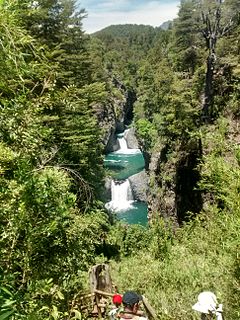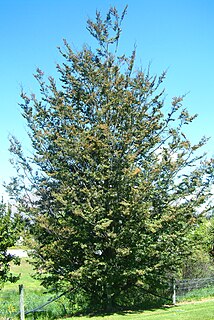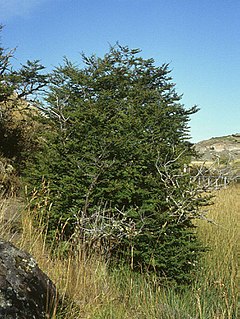
The Mount Nothofagus National Park is a protected national park located in the Northern Rivers region of New South Wales, Australia. The 2,180-hectare (5,400-acre) park is located approximately 634 kilometres (394 mi) north of Sydney and can be located via Kyogle via the Bruxner Highway and the Summerland Way.

The Magellanic subpolar forests are a terrestrial ecoregion of southernmost South America, covering parts of southern Chile and Argentina, and are part of the Neotropic ecozone. It is a temperate broadleaf and mixed forests ecoregion, and contains the world's southernmost forests.

Nothofagus pumilio is a deciduous tree or shrub in the Nothofagaceae family that is native to the southern Andes range, in the temperate forests of Chile and Argentina to Tierra del Fuego, from 35° to 56° South latitude. This tree is in the same genus as the coihue. It regenerates easily after fires. The wood is of good quality, moderate durability, and is easy to work with. It is used in furniture, shingles and construction and sometimes as a substitute for American black cherry in the manufacturing of cabinets.

Nothofagus gunnii, the tanglefoot- or deciduous beech, or fagus, is a deciduous shrub endemic to the highlands of Tasmania, Australia. It was discovered in 1847 by R.C Gunn and evidence exists that it once lived in Antarctica. N. gunnii is a small woody tree with a shrubby appearance known to grow up to 3 metres (9.8 ft). It lives only on mountains due to temperature limitations within the Tasmanian maritime climate and can survive up to heights of 1,400 metres (4,600 ft). It grows in alpine and sub-alpine regions in the west to central portions of the state but is absent from the mountains of the northeast. Though capable of reaching the size of a small tree, it rarely exceeds 2 metres (6.6 ft) in height, instead growing as a thick shrub or as a woody ground cover hence its common name of "tanglefoot".

Nothofagus moorei, commonly known as Antarctic beech, is an important Gondwana relict of the rainforests of the southern hemisphere. It occurs in wet, fire-free areas at high altitude in eastern Australia.

Nothofagus dombeyi is a tree species native to southern Chile and the Andean parts of Argentine Patagonia. It grows from 35 to 45° South latitude between 700 and 1,200 m above mean sea level. It forms dense forests such as those found in the Los Alerces and Nahuel Huapi national parks. It thrives in low hills with gentle slopes, being very demanding of water and soil; the largest forests are found on the slopes looking south, and the healthier specimens tend to grow on the banks of rivers and lakes. It sometimes forms mixed forests with Araucaria araucana (monkey-puzzle) trees, for example in the Villarrica National Park in Chile. It is a fast-growing and well-distributed species that lives in a range of climatic conditions.

Nothofagus fusca, commonly known as red beech is a species of southern beech, endemic to New Zealand, where it occurs on both the North Island and South Island. Generally it is found on lower hills and inland valley floors where soil is fertile and well drained. In New Zealand the species is called Fuscospora fusca.

Nothofagus truncata, or hard beech, is a species of tree endemic to New Zealand. Its common name derives from the fact that the timber has a high silica content, making it tough and difficult to saw. Hard beech is a tree up to 30m tall occurring in lowland and lower montane forest from latitude 35°S to 42°30'S, that is, from the north of the North Island southwards to Marlborough and south Westland in the South Island. In Taranaki it forms almost pure stands on the rugged sandstone country there and is partially deciduous, dropping many of its leaves at the end of the winter. N. truncata became known as Fuscospora truncata after 2013 in New Zealand.

Nothofagus solandri var. solandri, commonly called Black beech, is a variety of the tree species Nothofagus solandri, endemic to New Zealand. Black beech occurs on both the North and the South Island at low altitudes up to the mountains. The other variety of N. solandri is called Mountain beech or Nothofagus solandri var. cliffortioides, and grows at higher altitudes than black beech. In New Zealand the taxon is called Fuscospora solandri.

Nothofagus alpina, also called rauli or raulí beech is a species of plant in the Nothofagaceae family. A deciduous tree, it grows in Chile and Argentina, it reaches 50 m (160 ft) height and more than 2 meters (6.5 feet) in diameter. Its distribution goes from 35 to 42° South latitude. It is found on the Andes. It tolerates low temperatures and heavy winds. It has a straight and cylindrical trunk with grey bark. N. alpina was proposed to be renamed Lophozonia alpina in 2013.
Nothofagus baumanniae is a species of plant in the Nothofagaceae family. It is endemic to New Caledonia.

Nothofagus glauca, commonly known as hualo, is a species of plant in the family Nothofagaceae. It is a deciduous tree endemic to Chile. It grows from 34° to 37° South latitude. N. glauca was proposed to be renamed Lophozonia glauca in 2013
Nothofagus womersleyi is a species of plant in the Nothofagaceae family. It is endemic to West Papua (Indonesia). It was proposed to be renamed Trisyngyne womersleyi in 2013.

Radal Siete Tazas National Park is a national park located in Curicó Province, Maule Region, Chile. It lies in a pre-Andean area close to Descabezado Grande volcano.

Nothofagus obliqua, commonly known as the Patagonian oak', roble,pellín,roble pellín,and hualle in its early state of growth or roble beech, is a deciduous tree from Chile and Argentina. It grows from 33 to 43° south latitude. The northern extent of this tree's range in Chile is considered to be the Vizcachas Mountains and La Campana National Park. N. obliqua was propsed to be renamed Lophozonia obliqua in 2013.

Nothofagus nitida is an evergreen tree, native from Chile and Argentina, it lives from latitude 40° S to Última Esperanza.

Nothofagus solandri var. cliffortioides, commonly called mountain beech, is a species of Southern beech tree and is endemic to New Zealand. Mountain beech grows in mountainous regions at high altitudes. In New Zealand the taxon is called Fuscospora cliffortioides. Nothofagus solandri var. cliffortioides occupies a wider range of habitat than any other New Zealand tree species and it shows a corresponding range of life form, seeding habits, regenerative patterns, growth habits, growth rates, stand replacement and mortality patterns.

Nothofagus macrocarpa, commonly known as roble de Santiago or Santiago's oak, is a deciduous tree or shrub in the Nothofagaceae family that is endemic to the mountains of central Chile.
It is sometimes regarded as a subspecies of Nothofagus obliqua. N. macrocarpa proposed to be renamed Lophozonia macrocarpa in 2013.
















